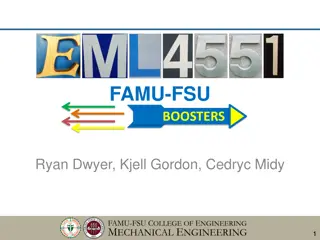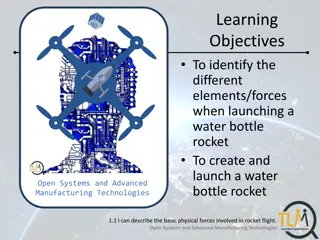Rocket Design and Safety Documentation for Altitude Targeting
This document outlines the detailed design and safety considerations for a rocket targeting a specific altitude. It covers materials used, rocket components and dimensions, motor selection and simulation, recovery system details, and electronic recovery mechanisms. Emphasis is placed on compliance with contest rules and ensuring stability through proper center of gravity and center of pressure calculations.
Download Presentation

Please find below an Image/Link to download the presentation.
The content on the website is provided AS IS for your information and personal use only. It may not be sold, licensed, or shared on other websites without obtaining consent from the author.If you encounter any issues during the download, it is possible that the publisher has removed the file from their server.
You are allowed to download the files provided on this website for personal or commercial use, subject to the condition that they are used lawfully. All files are the property of their respective owners.
The content on the website is provided AS IS for your information and personal use only. It may not be sold, licensed, or shared on other websites without obtaining consent from the author.
E N D
Presentation Transcript
Target Altitude Safety Document School Name Team Name 1
Rocket Design Include a list of materials used Include a drawing of the rocket identifying all of its components and their dimensions Total on the pad weight of rocket with the primary and backup motors. This includes All recovery harness and parachute Primary or backup motor Payload if required for event Location of Center of Pressure (CP) from the tip of the nose cone Location of Center of Gravity (CG) from the tip of the nose Primary motor Backup motor Identify the rocket s stability. The center of gravity (CG) must be ahead of the center of pressure (CP) by at least one diameter (caliber) of your rocket. With primary motor With backup motor 2
Primary and Secondary Motors Identify primary motor selection Document method for motor retention (friction fit is specifically disallowed). Calculate thrust to on pad weight ratio using average thrust of the primary motor Thrust to weight ratio must be a minimum of 5:1 Identify back up motor selection and what changes to rocket would be required to successfully comply with contest rules Calculate thrust to on pad weight ratio using average thrust of the backup motor Thrust to weight ratio must be a minimum of 5:1 Include a simulation plot for the primary motor Include a simulation plot for the backup motor 3
Recovery Document method of initiating recovery Electronic. If used, complete slide #5 Motor ejection - specify motor delay in seconds for Primary motor Secondary motor Parachute Size of and how determined Identify method for protecting parachute and rationale for choice Show drawing of recovery harnesses for each part of rocket Identify harness material and strength Identify linkages and load limits Identify eye bolts or u bolts and their mounting methods 4
Recovery Electronics - if used Identify commercial altimeter(s) that will be used Show wiring diagram of altimeters with charges Document the number and size of the pressure ports for altimeter Document altimeter preparation steps. Specify the quantity of black powder to be used to separate each section Specify the volume of the section to be pressurized with calculated pressure level Document charge size testing and results Specify how sections are secured before the ejection charges separate sections friction fit shear pins - number and size Other Identify how charges are fired e-matches other 5
Feedback For feedback from reviewers, please include an email address and contact information. 6























